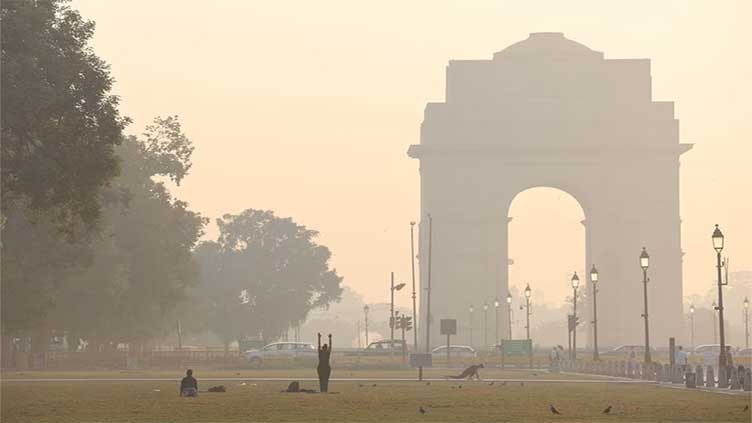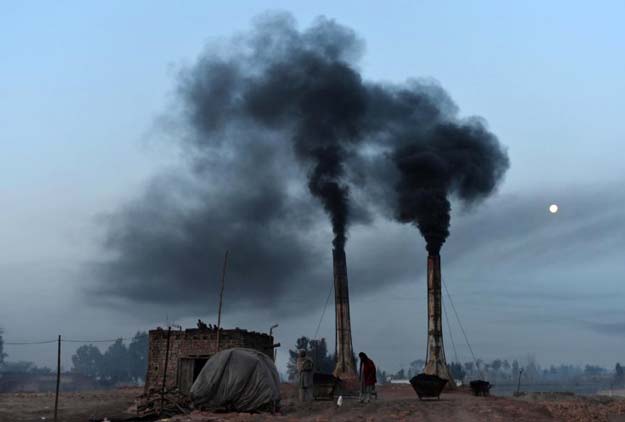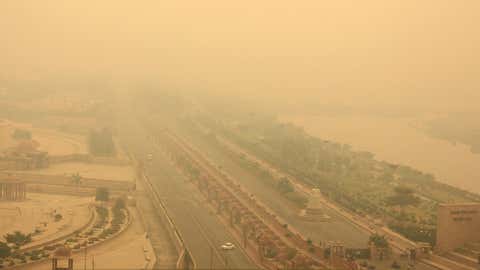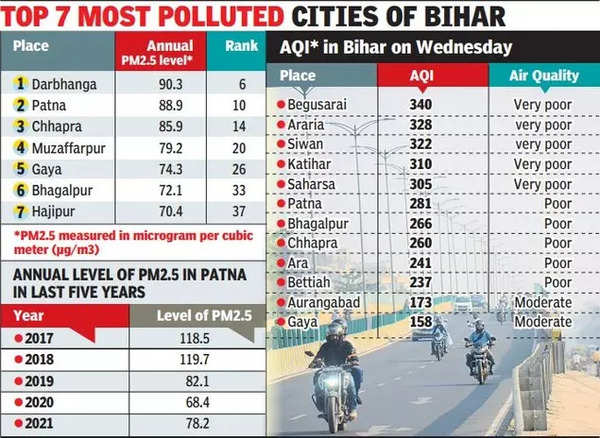فضائی آلودگی، جس کی پیمائش مائیکروگرام فی کیوبک میٹر ( μ g/m ³ ) میں PM2.5 حراستی سے کی جاتی ہے، صحت عامہ اور ماحولیات کے لیے ایک اہم خطرہ...
فضائی آلودگی، جس کی پیمائش مائیکروگرام فی کیوبک میٹر (μg/m³) میں PM2.5 حراستی سے کی جاتی ہے، صحت عامہ اور ماحولیات کے لیے ایک اہم خطرہ ہے۔ سب سے زیادہ متاثر ہونے والے شہر وہ ہیں جو ذرات کی اعلی سطح سے دوچار ہیں۔ یہ مضمون دنیا بھر میں سب سے زیادہ فضائی آلودگی والے 20 شہروں کی تفصیلات پر روشنی ڈالتا ہے، جو ان کی تاریخوں، معاون عوامل اور اصلاحی اقدامات کی فوری ضرورت پر روشنی ڈالتا ہے۔
1. لاہور،
پاکستان (97.4 μg/m³):
لاہور، جسے اکثر پاکستان کا ثقافتی مرکز سمجھا جاتا ہے، خود کو
فضائی آلودگی کی خطرناک سطح سے دوچار پاتا ہے۔ شہر، قدیم زمانے سے اپنی بھرپور تاریخ
کے ساتھ، تیزی سے شہری کاری اور صنعت کاری سے پیدا ہونے والے عصری چیلنجوں کا
سامنا ہے۔
2. ہوٹن، چین
(94.3 μg/m³):
سنکیانگ اویگور خود مختار علاقے میں واقع ہوتن اپنے تاریخی سلک
روڈ رابطوں کے لیے مشہور ہے۔ اپنی ثقافتی اہمیت کے باوجود، یہ شہر صنعتی ترقی اور
گاڑیوں کی بڑھتی ہوئی ٹریفک سے منسوب فضائی آلودگی کی بلند سطح کا مقابلہ کرتا ہے۔
3. بھیواڑی،
انڈیا (92.7 μg/m³):
بھارت کی شمالی ریاست راجستھان میں ایک صنعتی مرکز بھیواڑی نے
حالیہ دہائیوں میں کافی ترقی دیکھی ہے۔ تاہم، یہ پیشرفت بڑھتی ہوئی فضائی آلودگی کی
قیمت پر ہوتی ہے، جو بنیادی طور پر صنعتی اخراج اور شہری پھیلاؤ کی وجہ سے پیدا
ہوتی ہے۔
4. دہلی،
انڈیا (92.6 μg/m³):
بھارت کا دارالحکومت دہلی فضائی آلودگی کے خلاف جنگ میں سب سے
آگے ہے۔ ایک بھرپور تاریخی ٹیپسٹری کے ساتھ، شہر اب تیزی سے شہری کاری، گاڑیوں کے
اخراج اور صنعتی سرگرمیوں کے اثرات سے دوچار ہے۔
5. پشاور،
پاکستان (91.8 μg/m³):
پاکستان کے قدیم ترین شہروں میں سے ایک کے طور پر، پشاور تاریخی
دلکشی اور عصری چیلنجوں کے امتزاج کا گواہ ہے۔ فضائی آلودگی کے ساتھ شہر کی جدوجہد
شہری ترقی اور صنعتی پیداوار سے پیدا ہونے والے وسیع تر ماحولیاتی خدشات کی عکاسی
کرتی ہے۔
6. دربھنگہ،
انڈیا (90.3 μg/m³):
دربھنگا، بھارتی ریاست بہار کا ایک شہر، اس خطے کی ثقافتی اور تاریخی میراث کا ثبوت ہے۔ تاہم، فضائی آلودگی کا وسیع مسئلہ شہریکرن اور صنعتی ترقی کے ذریعے کیے جانے والے ماحولیاتی نقصان کی نشاندہی کرتا ہے۔
7. آسوپور،
انڈیا (90.2 μg/m³):
ایک چھوٹا شہری مرکز لیکن اس سے کم متاثر نہیں، آسوپور کو فضائی
آلودگی کا سامنا ہے، یہاں تک کہ کم گنجان آبادی والے علاقوں میں بھی چیلنجز کو نمایاں
کیا گیا ہے۔ زرعی طریقوں اور صنعتی اخراج کا باہمی تعامل شہر کی آلودگی کے بوجھ میں
حصہ ڈالتا ہے۔
8. N'Djamena، Chad
(89.7 μg/m³):
چاڈ کے دارالحکومت اور سب سے بڑے شہر کے طور پر، N'Djamena
کو چیلنجوں کے ایک منفرد سیٹ کا سامنا ہے جو اس کی اعلی فضائی
آلودگی کی سطح میں حصہ ڈالتے ہیں۔ تیزی سے آبادی میں اضافہ اور محدود ماحولیاتی
ضوابط جیسے عوامل جامع مداخلت کی ضرورت پر زور دیتے ہیں۔
9. نئی دہلی،
انڈیا (89.1 μg/m³):
وسیع تر قومی دارالحکومت کے علاقے کے ایک لازمی حصے کے طور پر،
نئی دہلی ہوا کے معیار کے شدید مسائل سے دوچار ہے۔ تاریخی اور سیاسی اہمیت کی
علامت ہونے کے باوجود، شہر کو مختلف ذرائع سے آلودگی کو کم کرنے کے جدید دور کے چیلنج
کا سامنا ہے۔
10. پٹنہ،
انڈیا (88.9 μg/m³):
پٹنہ، دنیا کے سب سے قدیم مسلسل آباد مقامات میں سے ایک، اپنے
بھرپور ثقافتی اور تاریخی ورثے کا گواہ ہے۔ تاہم، فضائی آلودگی کے خلاف شہر کی
جدوجہد شہری کاری، صنعتی ترقی، اور ماحولیاتی تحفظ کے درمیان پیچیدہ تعامل پر زور
دیتی ہے۔
11. غازی
آباد، انڈیا (88.6 μg/m³):
ریاست اتر پردیش کا ایک صنعتی شہر، غازی آباد کی تیز رفتار شہری
ترقی ہوا کے معیار کی قیمت پر ہوئی ہے۔ شہر کی تاریخی اہمیت آلودگی سے نمٹنے اور
صحت عامہ کی حفاظت کی عصری عجلت کے ساتھ جڑی ہوئی ہے۔
12. دھروہیرا،
انڈیا (87.8 μg/m³):
ہریانہ کی ریاست کا ایک قصبہ دھروہرہ، فضائی آلودگی سے نمٹنے میں
چھوٹے شہری مراکز کو درپیش چیلنجوں کی عکاسی کرتا ہے۔ صنعتی سرگرمیوں، گاڑیوں کے
اخراج اور ماحولیاتی انحطاط کے درمیان گٹھ جوڑ مقامی حل کی ضرورت پر زور دیتا ہے۔
13. بغداد،
عراق (86.7 μg/m³):
عراق کے دارالحکومت کے طور پر، بغداد اسلامی سنہری دور کے مرکز
کے طور پر اس کی حیثیت سے نشان زد ایک بھرپور تاریخ کا حامل ہے۔ اپنی تاریخی اہمیت
کے باوجود، یہ شہر عصری چیلنجوں کا مقابلہ کرتا ہے، بشمول تنازعات سے متعلق سرگرمیوں
اور شہری کاری جیسے عوامل سے چلنے والی فضائی آلودگی۔
14. چھپرا،
انڈیا (85.9 μg/m³):
چھپرا، ریاست بہار میں واقع ہے، اپنی تاریخی جڑوں کے باوجود
فضائی آلودگی کی بلند سطح سے دوچار ہے۔ شہر کی جدوجہد صنعتی ترقی، زرعی طریقوں اور
آبادی کی کثافت سے پیدا ہونے والے وسیع تر ماحولیاتی خدشات کی عکاسی کرتی ہے۔
16. فیصل آباد، پاکستان (84.5 μg/m³):
فیصل آباد، جسے اپنی صنعتی صلاحیتوں کی وجہ سے اکثر
"پاکستان کا مانچسٹر" کہا جاتا ہے، تیزی سے صنعت کاری کے نتائج سے دوچار
ہے۔ شہر کی تاریخی جڑیں فضائی آلودگی سے نمٹنے اور پائیدار ترقی کو فروغ دینے کے لیے
عصری ضرورت کے ساتھ جڑی ہوئی ہیں۔
17. گریٹر
نوئیڈا، انڈیا (83.2 μg/m³):
شمالی ہندوستان کی ریاست اتر پردیش میں ایک منصوبہ بند شہر کے
طور پر، گریٹر نوئیڈا شہری ترقی اور ماحولیاتی تحفظ کے چیلنجوں کا مظہر ہے۔ فضائی
آلودگی کے خلاف شہر کی جدوجہد جامع منصوبہ بندی اور پائیدار طریقوں کی ضرورت پر
زور دیتی ہے۔
18. بہادر
گڑھ، انڈیا (82.2 μg/m³):
بہادر گڑھ، ریاست ہریانہ کا ایک شہر، شہری کاری اور صنعتی ترقی
کے نتائج سے دوچار ہے۔ شہر کے تاریخی پس منظر کو فضائی آلودگی پر قابو پانے اور
رہائشیوں کی فلاح و بہبود پر اس کے اثرات کو کم کرنے کی اہم ضرورت کے ساتھ جوڑ دیا
گیا ہے۔
19. فرید
آباد، انڈیا (79.7 μg/m³):
قومی راجدھانی کے علاقے کے اٹوٹ انگ کے طور پر، فرید آباد کو
فضائی آلودگی کا مقابلہ کرتے ہوئے صنعتی مرکز ہونے کے دوہرے چیلنج کا سامنا ہے۔
شہر کے تاریخی اور صنعتی پہلوؤں کو پائیدار شہری ترقی کو یقینی بنانے کے لیے اسٹریٹجک
مداخلت کی ضرورت ہے۔
20. مظفر
پور، انڈیا (79.2 μg/m³):
مظفر پور، جو ریاست بہار میں واقع ہے، اپنی تاریخی اہمیت کے درمیان
فضائی آلودگی سے دوچار ہے۔ شہر کی جدوجہد صنعتی سرگرمیوں، گاڑیوں کے اخراج، اور
ماحولیاتی بہبود کے درمیان پیچیدہ روابط کو حل کرتے ہوئے ایک جامع نقطہ نظر کی
ضرورت کو اجاگر کرتی ہے۔
آخر میں، ان 20 شہروں میں فضائی آلودگی کی خطرناک سطح جامع حکمت
عملیوں اور مداخلتوں کی فوری ضرورت پر زور دیتی ہے۔ عصری چیلنجوں کے ساتھ تاریخی
وراثت کو متوازن کرتے ہوئے، ان شہری مراکز کو موجودہ اور آنے والی نسلوں کی فلاح و
بہبود کے لیے ماحولیاتی پائیداری کو ترجیح دینے میں ایک اہم لمحے کا سامنا ہے۔ آگے
بڑھنے کے لیے مشترکہ کوششوں، سخت ضابطوں، اور ایک صاف ستھرا اور صحت مند مستقبل کو
یقینی بنانے کے لیے پائیدار طرز عمل کے عزم کی ضرورت ہے۔













No comments